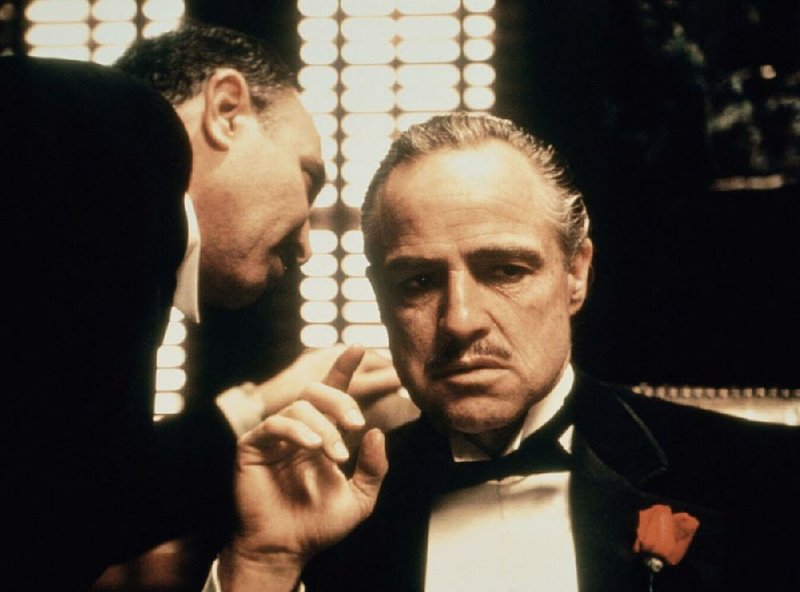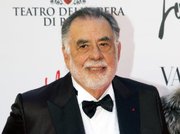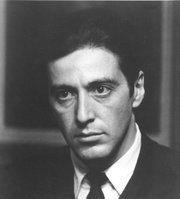Newspapers like anniversaries, even odd ones like the 45th (the traditional gift is sapphire). So can you believe it has been 45 years since Francis Ford Coppola's The Godfather opened in American theaters?
Maybe. If you remember seeing The Godfather in its initial run, you can probably appreciate how much and how little America has changed. Back then, Richard Nixon was president, we were fighting in Vietnam and there seemed a real chance our country might fly apart. What seems most remarkable is that The Godfather opened in March, a month Hollywood studios now consider a dumping ground for unpromising films.
While the movie calendar hadn't quite been codified in 1972, Paramount Pictures was expecting nothing more or less than a genre mob movie when it commissioned rising star 33-year-old Coppola to direct a film version of Mario Puzo's best-selling page turner. Coppola wasn't exactly an unknown; he'd never had a hit but he had been around for awhile. He had written and directed four features including the musical Finian's Rainbow (1968) and the semi-experimental feature The Rain People (1969), about a disillusioned suburban housewife (Shirley Knight) who, after she discovers she's pregnant, lights out for the territories, running to the west away from her conventional marriage. Along the way she picks up a hitchhiker, a brain-damaged former college football player, played by future Godfather cast member James Caan. Another future Godfather player -- Robert Duvall -- shows up as a highway patrolman.
It is a rambling, at times nearly incoherent film about dissatisfaction and searching, and it fits in with other better known "New Hollywood" films from the same year, Easy Rider and Midnight Cowboy. But what gave Coppola a little traction was the script he had written for Patton, which won the first Academy Award for Original Screenplay. He shared it with Edmund North, a veteran screenwriter who was called after director Franklin J. Schaffner expressed concern about Coppola's first draft.
"I wrote the script of Patton," Coppola says in a filmed interview for the American Academy of Achievement (you can see it at goo.gl/giW6lf). "And the script was very controversial when I wrote it, because they thought it was so stylized. It was supposed to be like, sort of, you know, The Longest Day. And my script of Patton was -- I was sort of interested in the reincarnation. And I had this very bizarre opening where he stands up in front of an American flag and gives this speech. Ultimately, I wasn't fired, but I was fired, meaning that when the script was done, they said, 'OK, thank you very much,' and they went and hired another writer and that script was forgotten. And I remember very vividly this long, kind of being raked over the coals for this opening scene."
But George C. Scott had read Coppola's script and liked it. He only agreed to take the lead part if Coppola's script was used.
But even after Patton's success -- it won seven Oscars and was a box office hit -- Coppola was not Paramount's first choice to direct The Godfather. Initially offered the job was Italian director Sergio Leone, but he turned them down to direct his gangster opus Once Upon a Time in America. Next they approached Peter Bogdanovich, who mulled the job over -- he has said he would have cast Edward G. Robinson as Don Vito Corleone had he made the film -- before deciding to make the screwball comedy What's Up, Doc? instead. Reportedly Peter Yates, Richard Brooks, Arthur Penn, the Greek-French director Costa-Gavras and Otto Preminger were all approached by Paramount about the job.
For his part, Coppola was reluctant. He had tried to read the popular Mario Puzo novel that served as source material for the film but had been repulsed by its sex scenes and stopped around page 50. "I was disappointed in the book when I first read it," a diplomatic Coppola said last week at a reunion of the casts of The Godfather and The Godfather II that closed out the Tribeca Film Festival. (He'd previously characterized the novel as "pretty cheap stuff.")
In the documentary The Kid Stays in the Picture, Robert Evans, Paramount's head at the time, remembers that Coppola was also concerned that the film might be seen as glorifying Mafia violence and that it would reflect poorly on Sicilians and Italians. But Evans felt strongly that the film needed to be directed by an Italian-American -- he wanted to "smell the spaghetti."
But Coppola needed money -- his production company, American Zoetrope, owed more than $500,000 to Warner Bros. One of Coppola's partners, George Lucas, urged him to do the film strictly for the money.
"I had two kids, one on the way, and I was totally broke," Coppola said at the Tribeca event. "And I knew that if they fired me, then they'd have to pay me."
. . .
Paramount had optioned Puzo's story before it became a novel, and after the novel became a best-seller, the expectations and budget for the project went up. What was originally conceived as a $2.5 million budget rose to $6 million, enough to support a genuine period production -- New York in the 1940s -- and a real star in the lead role. The studio wanted Laurence Olivier, Ernest Borgnine or Danny Thomas to play Don Corleone.
Coppola wanted Marlon Brando, by then widely considered a has-been. Paramount agreed to consider Brando, but insisted he screen-test for the role. Coppola, understanding the fragility of Brando's ego, never asked his star for a screen test. Instead, he showed the studio makeup tests Brando had filmed himself at home.
In his autobiography, Songs My Mother Taught Me, Brando remembered:
"I went home and did some rehearsing to satisfy my curiosity about whether I could play an Italian. I put on some makeup, stuffed Kleenex in my cheeks, and worked out the characterization first in front of a mirror, then on a television monitor. After working on it, I decided I could create a characterization that would support the story. The people at Paramount saw the footage and liked it, and that's how I became the Godfather."
But how did a potboiling crime novel, one allegedly written to cover its author's gambling debts, become such a monumental American epic? Certainly Paramount saw its potential, especially after Puzo's novel (which might be more properly thought of as a novelization, since he wrote it after selling Paramount a detailed treatment of the story) became a hit, but it's obvious they saw it as a crime movie. At one point they suggested, as a cost-saving measure, setting the film in present-day Kansas City.
But Coppola imagined it as a metaphor for American capitalism, suggesting the difference between the Corleones and the Kennedys was simply a matter of perception. The Godfather is a story about a dream going straight, or trying to. Time and again it comes back to themes of legitimacy and acceptance and how old loyalties and expectations frustrate the immigrant aspiration. It's about how power has its roots in crime.
Coppola's executive mobsters -- the Corleones, Lee Strasberg's Hyman Roth -- are businessmen first, and like the heads of corporations that make money from the misery of the poor and powerless, they can love their children and be inveigled by guilt. Michael, the family's Hamlet, goes from Yale law school into the family business out of a sense of duty and responsibility, not because he sees himself as a kind of romantic outlaw.
Brando's Vito Corleone is nothing less than a gangster saint who eschews drug dealing and sees his role as a peace broker with obligations, who only does what he has to do to escape the Mott Street mob. It indulges the nostalgic myth that criminals once followed a code. The Godfather is an American masterpiece, a fluky blend of myth and propaganda bathed in deliberately dark honey light by cinematographer Gordon Willis. It just happened to combine great acting, memorable dialogue and one of those cheesy, slouching-toward-highbrow scores movie audiences adore.
Most importantly, it was the first movie to break the $100 million mark at the box office. And Coppola thinks it could never be made in today's franchise-centric studio environment. He remembers how the late MGM head Kirk Kerkorian once asked him how he could make a film "successful financially and also artistically."
He gave him a one-word answer: "Risk."
So, yes, things have changed in 45 years.
Email:
pmartin@arkansasonline.com
blooddirtangels.com
Style on 05/07/2017


